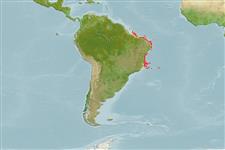>
Blenniiformes (Blennies) >
Blenniidae (Combtooth blennies) > Salariinae
Etymology: Hypleurochilus: Greek, hypo = under + Greek, pleura = in the side of + Greek, cheilos = lip; brasil: Named after the vivid red spots, similar to incandescent pieces of a brazing; Brazil’s country name (Brasil in Portuguese), where the species is endemic, originally has a similar derivation (name given in recognition of the reddish colour of the wood of a large Brazilian native tree - Caesalpinia echinata, 'Pau-Brasil' in Portuguese); noun in apposition..
Environment: milieu / climate zone / depth range / distribution range
Οικολογία
Θαλασσινό(ά) Υφαλόφιλο(α); εύρος βάθους 3 - 15 m (Ref. 94079). Tropical
Western Atlantic: Brazil (Trindade Island and Martin Vaz).
Μέγεθος / Βάρος / Age
Maturity: Lm ? range ? - ? cm
Max length : 3.1 cm SL αρσενικό/απροσδιόριστο; (Ref. 94079); 2.7 cm SL (female)
Short description
Μορφολογία | Μορφομετρία
Ραχιαίες άκανθες (συνολικά): 12; Μαλακές ραχιαίες ακτίνες (συνολικά): 13-14; Εδρικές άκανθες 2; Μαλακές εδρικές ακτίνες: 15 - 16; Σπόνδυλοι: 36. This species is distinguished from its congeners by the following set of characters: pelvic-fin rays I, 3, dorsal fin usually XII,13, anal fin II,15-16 (usually 16), no blackened stripes, nape green or white and presence of numerous tiny red spots along body, diminishing in size posteriorly (Ref. 94079).
Found either solitary or in small groups of up to 10 individuals; in small holes or associated with sea-urchins and sponges on the rocky reefs (Ref. 94079). Oviparous. Eggs are demersal and adhesive (Ref. 205), and are attached to the substrate via a filamentous, adhesive pad or pedestal (Ref. 94114). Larvae are planktonic, often found in shallow, coastal waters (Ref. 94114).
Life cycle and mating behavior
Γεννητική Ωρίμανση | Αναπαραγωγή | Γεννοβολία | Αβγά | Γονιμότητα | Προνύμφες
Pinheiro, H.T., J.L. Gasparini and C.A. Rangel, 2013. A new species of the genus Hypleurochilus (Teleostei: Blenniidae) from Trindade Island and Martin Vaz Archipelago, Brazil. Zootaxa 3709(1):95-100. (Ref. 94079)
IUCN Red List Status (Ref. 130435)
Threat to humans
Harmless
Human uses
Περισσότερες πληροφορίες
Κοινά ονόματαΣυνώνυμαΜεταβολισμόςΘηρευτέςΟικοτοξικολογίαΑναπαραγωγήΓεννητική ΩρίμανσηΓεννοβολίαΣυναθροίσεις γεννοβολίαςΓονιμότηταΑβγάEgg development
Age/SizeΑύξησηLength-weightLength-lengthLength-frequenciesΜορφομετρίαΜορφολογίαΠρονύμφεςΔυναμική προνυμφώνΣτρατολόγησηΑφθονίαBRUVS
ΑναφορέςΥδατοκαλλιέργειεςΠροφίλ υδατοκαλλιέργειαςΣτελέχοιΓενετικήElectrophoresesΚληρονομικότηταΑσθένειεςΜεταποίησηNutrientsMass conversion
ΣυνεργάτεςΦωτογραφίεςStamps, Coins Misc.ΉχοιΣιγκουατέραΤαχύτηταΚολυμβητικός ΤύποςΕπιφάνεια βραγχίωνOtolithsΕγκέφαλοιΌραση
Εργαλεία
Special reports
Download XML
Διαδικτυακές πηγές
Estimates based on models
Preferred temperature (Ref.
123201): 25.8 - 27.6, mean 27.4 °C (based on 98 cells).
Phylogenetic diversity index (Ref.
82804): PD
50 = 0.5005 [Uniqueness, from 0.5 = low to 2.0 = high].
Bayesian length-weight: a=0.00741 (0.00335 - 0.01640), b=3.02 (2.83 - 3.21), in cm total length, based on LWR estimates for this (Sub)family-body shape (Ref.
93245).
Τροφικό Επίπεδο (Ref.
69278): 3.1 ±0.3 se; based on size and trophs of closest relatives
Ελαστικότητα (Ref.
120179): Υψηλό, ελάχιστος χρόνος για διπλασιασμό πληθυσμού < 15 μήνες (Preliminary K or Fecundity.).
Fishing Vulnerability (Ref.
59153): Low vulnerability (10 of 100).
